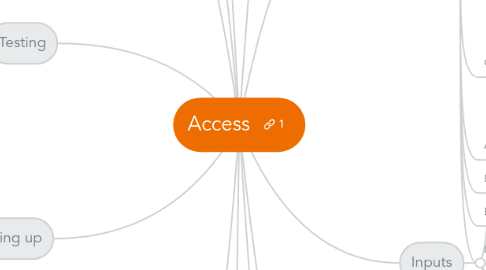
1. Testing
1.1. Validation
1.1.1. Rules
1.1.1.1. Data type
1.1.1.2. Range
1.1.1.3. Presence
1.1.1.4. Format
1.1.2. Text
1.2. Data integrity
1.3. Verification
2. Links to other software
2.1. Importing data CSV
2.2. Data logging
2.3. Google forms
2.4. Mail merge
2.4.1. Word processors
2.4.2. DTP
2.5. Data Collection
2.5.1. Open ended vs Closed qestions
2.5.2. Online
2.5.2.1. Google Forms
2.5.3. Ready Made Data Sets
2.5.4. Data Logging
2.5.5. Analogue vs Digital Data
3. Backing up
3.1. Versions
3.1.1. Grandfather
3.1.2. Father
3.1.3. Son
4. Users
4.1. Access rights
4.2. Multiple users
4.3. Data Security
4.4. Password protection
5. Evaluating
5.1. Compare expected results with actual
5.2. Compare data collected with alternate samples
6. Audience
6.1. Most appropriate input / output
7. Alternative Software
7.1. Excel
7.2. Branching Databases
7.2.1. @simonhaughton
7.2.1.1. Lesson ideas
7.2.1.2. Ask Oscar
7.2.1.3. Sample data
7.3. 2investigate
7.3.1. Lesson ideas
7.3.1.1. @simonhaughton
7.3.1.1.1. Introducing databases
7.3.1.2. @chrisleach78
7.3.1.2.1. Top Trumps
7.3.1.2.2. Games consoles Top Trumps
7.4. @simonhaughton
7.4.1. KS1 data handling ideas
7.5. Super Trumps
8. Introduction
8.1. What is a database?
8.2. Examples of how databases are used in the real world
8.2.1. Internet search engines
8.2.2. Police Database
8.3. Advantages of data handling
8.4. Disadvantages of data handling
8.5. Comparison to spreadsheets
8.6. Lesson ideas
8.6.1. NGfL Cymru
8.6.1.1. Whoddunit - solve the mystery
8.6.2. Wordsearch maker
8.6.2.1. Database terminology
8.6.3. E-Fit
9. Basics
9.1. Data Structure
9.1.1. Fields (columns)
9.1.1.1. Data types
9.1.1.1.1. text
9.1.1.1.2. Number
9.1.1.1.3. String
9.1.1.1.4. Date/Time
9.1.1.1.5. Boolean
9.1.1.1.6. Others
9.1.1.2. Field lengths vs default
9.1.1.3. Primary Key Field
9.1.1.3.1. Autonumber
9.1.2. Records (Rows)
9.1.3. Files
9.1.4. How to design
9.1.4.1. Questions database needs to answer
9.1.4.2. Questions needed to create database
9.1.4.3. Articles
9.1.4.3.1. MS Server crash nearly causes 800 plane pile up
9.1.5. Lesson ideas
9.1.5.1. NGfL Cymru
9.1.5.1.1. Interactive animation about creating databases
9.2. Tables
9.2.1. Flat file vs Relational
9.3. Comparisons with Spreadsheets
9.3.1. Advantages
9.3.2. Disadvantages
9.3.3. Differences
9.3.4. Similarities
9.4. Add a record
9.5. Delete a record
9.6. Edit record
9.7. Lesson ideas
9.7.1. @largerama
9.7.1.1. Sherlock Holmes Detective Game
10. Outputs
10.1. Reports
10.1.1. Design Considerations
10.1.1.1. Wizard vs Design View
10.1.1.2. Formatting
10.1.1.3. Headers & Footers
10.2. Searching data
10.2.1. Query Design
10.2.1.1. Wizard
10.2.1.2. Custom (design view)
10.2.1.2.1. Use of operators (>, <>, >=, etc)
10.2.1.3. Simple vs Complex
10.2.1.4. Saving queries
10.2.1.5. Running queries
10.2.2. Lesson ideas
10.2.2.1. NGfL Cymru
10.2.2.1.1. Interactive search one field
10.2.2.1.2. Interactive search two fields
10.3. Sorting Data
10.3.1. Simple vs Complex
10.3.2. Lesson ideas
10.3.2.1. NGfLCymru
10.3.2.1.1. Interactive animation
10.4. Charts / Graphs
10.5. Using calculations in fields
11. Inputs
11.1. User Interfaces
11.1.1. Tables
11.1.1.1. List view
11.1.2. Forms
11.1.2.1. Wizard vs Design view
11.1.2.2. Formatting
11.1.2.3. Headers & Footers
11.2. Use of drop down lists
11.2.1. How to construct
11.2.2. Allow additional entries vs limit to list
11.3. Input masks / characters
11.4. Reliability of data collected
11.4.1. Why use some data
11.4.2. Why not use other data
